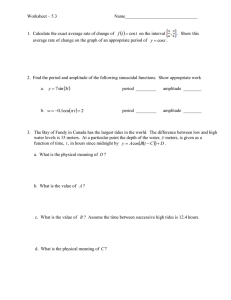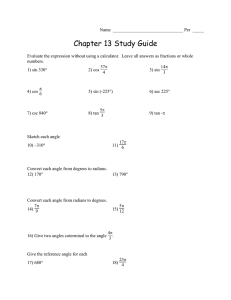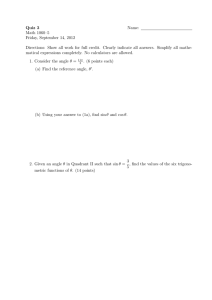ANALYSIS OF THE FM SPECTRUM
advertisement
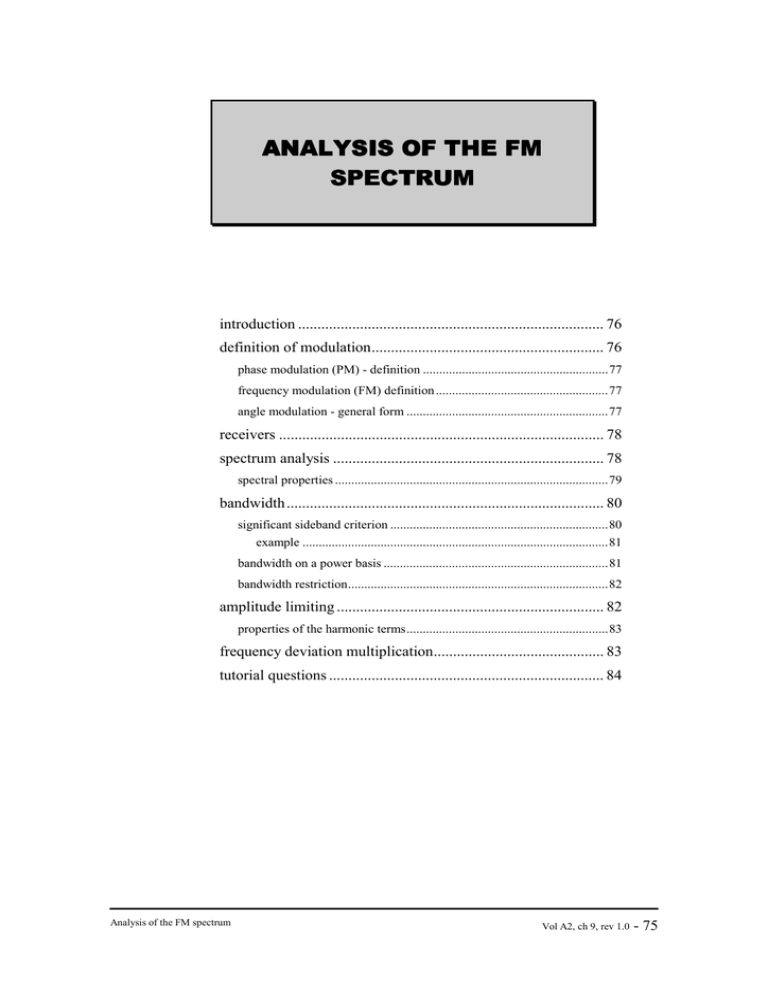
ANALYSIS OF THE FM SPECTRUM introduction ............................................................................... 76 definition of modulation............................................................ 76 phase modulation (PM) - definition .........................................................77 frequency modulation (FM) definition .....................................................77 angle modulation - general form ..............................................................77 receivers .................................................................................... 78 spectrum analysis ...................................................................... 78 spectral properties ....................................................................................79 bandwidth.................................................................................. 80 significant sideband criterion ...................................................................80 example ..............................................................................................81 bandwidth on a power basis .....................................................................81 bandwidth restriction................................................................................82 amplitude limiting ..................................................................... 82 properties of the harmonic terms..............................................................83 frequency deviation multiplication............................................ 83 tutorial questions ....................................................................... 84 Analysis of the FM spectrum Vol A2, ch 9, rev 1.0 - 75 ANALYSIS OF THE FM SPECTRUM introduction To understand the next few experiments it is necessary to have a basic understanding of the nature of phase modulated (PM) and frequency modulated (FM) signals. These notes define the angle modulated signal, of which PM and FM are special cases. FM, under well defined conditions, offers certain features, including a method of trading bandwidth for signal-to-noise ratio. These notes will not discuss signal-tonoise properties, but instead will concentrate on an analysis of the spectral properties of the signal. definition of modulation Consider the signal: y(t) = E.cos(ωt + φ) ........ 1 This signal possesses, by definition: • an amplitude ‘E’ • a total phase (ωt + φ) • an instantaneous frequency defined as the time rate of change of total phase. Any one of these three parameters may be modulated by a message A.cosµt. Which ever parameter is chosen, then, by definition: • the rate of variation of the chosen parameter should be directly proportional to the rate of variation of the message alone (µ) • the amount of variation of the chosen parameter should be directly proportional to the amplitude of the message alone (A) Other parameters may vary at the same time, as will be seen in what follows, but these variations will not be strictly in accordance with the above definitions. 76 - A2 Analysis of the FM spectrum phase modulation (PM) - definition According to the above requirements a signal will be phase modulated, by the message A.cosµt, if: ........ 2 total phase = ωt + k .cosµt 1 and provided k1 is linearly proportional to A, the message amplitude. Hence: PM = E cos(ωt + k1 cos µt ) ........ 3 is a phase modulated signal. Note that, for PM: instantaneous frequency = ω - k1.µ.cosµt ........ 4 Although the frequency is also varying with the message, the variation is not directly proportional to the message amplitude alone. Hence, by definition, this is not frequency modulation. frequency modulation (FM) definition According to the above requirements a signal will be frequency modulated, by the message A.cosµt, if: ........ 5 instantaneous frequency = ω + k .cosµt 2 and provided k2 is linearly proportional to A, the message amplitude. The total phase is obtained by integration of the instantaneous frequency, and thus the signal itself must be: k FM = E.cos(ωt + 2 sin µt ) µ ........ 6 Although the phase is also varying with the message, the variation is not directly proportional to the message amplitude alone. Hence, by definition, this is not phase modulation. angle modulation - general form The defining equation, for both PM and FM, can be written in the form: y(t) = E.cos(ωt + β.sinµt) ........ 7 One can choose β to represent either PM or FM as the case may be, and according to the definitions above. Thus: ........ 8 for PM β = ∆φ, the peak phase deviation and for FM β = ∆φ / µ ........ 9 The parameter β is often called the deviation. Both PM and FM fall into a class known as angle modulated signals. Analysis of the FM spectrum A2 - 77 receivers There are demodulators for these signals. The demodulator in a PM receiver responds in a linear manner to the variations in phase of the PM signal, and the receiver output is a copy of the original message. Likewise the demodulator in an FM receiver responds in a linear manner to the instantaneous frequency variations of the FM signal. There is an output from a PM receiver if the input is an FM signal, and from an FM receiver if the input is a PM signal. But these outputs will not be related to the message in a linear manner. In the experiment entitled Envelopes (in volume A1) a general expression is defined for a modulated signal, namely: ........ 10 y(t) = a(t).cos[ωt + φ(t)] where a(t) and φ(t) were defined as involving components at or near the message frequency only. The envelope was defined as being |a(t)|. Phase variations are described by φ(t). By definition, the output from both a PM and an FM receiver will be φ(t), provided a(t) is a constant. spectrum analysis The spectrum of the angle modulated signal y(t) of eqn.(7) above can be obtained by trigonometrical expansion. This is an interesting exercise, and you should do it yourself, since it is instructive to see where the various terms in the expansion come from. Firstly you will need to know that: cos(β.sinφ) = J0(β) + 2 [ J2(β).cos2φ + J4(β).cos4φ + ..................] ........ 11 sin(β.sinφ) = 2 [ J1(β).sinφ + J3(β).sin3φ + J5(β).sin5φ + ............] ........ 12 cos(β.cosφ) = J0(β) - 2 [ J2(β).cos2φ - J4(β).cos4φ + ....................] ........ 13 sin(β.cosφ) = 2 [ J1(β).cosφ - J3(β).cos3φ + J5(β).cos5φ - ..............] ........ 14 Here Jn(β) is a Bessel function of the first kind, argument β, and order n. You will also need to know that: J− n (β ) = ( −1)n Jn (β ) 78 - A2 ........ 15 Analysis of the FM spectrum Using the above formulae, y(t) of eqn.(7) can be expanded into two infinite series. These can be combined, and then condensed, into the compact form: n =∞ y(t ) = E. ∑ Jn (β ).cos(ω 0 + nµ )t n =−∞ ........ 16 Notice that the choice of +cos() and +sin() in the defining equation (7) leads to +cos() in the compact version of eqn.(16). A different combination of cos and sin in the defining equation will produce a different looking compact version. Whilst the frequency and amplitudes in each must be the same (why ?) the phases will inevitably be different. It is difficult and unnecessary to memorise the exact form of any of these expansions of the defining equation. spectral properties Despite the apparent complexity of eqn.(16), which describes the spectrum of the signal, it is a surprisingly easy matter to make and remember many general observations about the nature of this spectrum. What you should commit to memory is the general trends of the Bessel functions, which are illustrated in Figure 1 below. 1.0 J 0 ( β ) J ( β ) 1 J 2 ( β ) 0 - 0.4 0 10 5 argument 15 β Figure 1: Plots of Bessel Functions Notice that, as a function of β, all the curves are damped oscillatory. Except for J0(β), they start from zero, rise to a positive maximum, then oscillate about zero with ever decreasing amplitudes (damped). The exception, J0(β), starts from an amplitude of unity. Their zero crossings are not uniform, so the functions are not periodic. If you remember these general trends you will be able to make many qualitative observations about the behaviour of the FM spectrum. By a careful examination of eqn.(16), and the plots of the Bessel functions in Figure 1, the following properties can be deduced. It is useful to retain an understanding of them all: Analysis of the FM spectrum A2 - 79 • spectral components are numbered left and right (±) counting from the central component at ω (number n = 0). • the spectral lines are spaced µ/(2π) Hz apart • amplitude of the ±nth component from the centre is E.Jn(β). Because of eqn.(15) these two components are of equal amplitudes. Thus the spectrum is symmetrical about the central component at ω. • the bandwidth is mathematically infinite, but in engineering terms the signal is considered confined within limits which contain all ‘significant components’. • you should have an understanding of the term ‘significant sidebands’ (or spectral components). This is discussed below. • as β increases, the bandwidth, however defined, increases • as β increases, individual spectral lines do not increase in amplitude monotonically. Their amplitudes are determined by Jn(β), plots of which appear in Figure 1. • for particular values of β the amplitude of particular sidefrequency pairs becomes zero (these are the ‘Bessel zeros’). • the total power in the spectrum is constant, and independent of β. This can be deduced in more than one way. It is easy if you know that: n =∞ ∑ Jn2(β)= 1 n =−∞ • the largest ever component is the one at ω rad/s (often called the ‘carrier’), for the special case when β = 0 • sidefrequency pairs are alternately in phase-quadrature, and in-phase, with the term at ω (perhaps this is less obvious) bandwidth As engineers we should always know the bandwidth of the signals with which we are dealing. In many cases bandwidth estimation is not difficult. But for an angle modulated signal there is no single, closed form formula. Mathematically the bandwidth of the angle modulated signal of eqn.(7) is infinite, since the amplitude of the component nµ rad/s from the central component is E.Jn(β), and this only approaches zero as n approaches infinity. significant sideband criterion Fortunately, as engineers, practical concerns enable us to overcome this apparent problem. Firstly, we only require a component to be relatively small for us to be able to ignore it. This requires some sort of reference. For this we use the amplitude of the unmodulated carrier, which is E.J0(0) (which is equal to E, since J0(0) = 1). Insignificance is then defined as some fraction of the reference. Thus we have the ‘1% significant sideband criterion’, which declares a component insignificant if it is 1% or less of the reference. Secondly, if we can define a minimum width window in the frequency spectrum outside of which there are no components of significance, then this window will define its bandwidth. There is no simple formula for evaluating the width of this window, although there are several well known ‘rules of thumb’. 80 - A2 Analysis of the FM spectrum example Let us examine the spectrum of the angle modulated signal, defined by eqn.(7), with: β = 5, and µ / (2π) = 3 kHz Reference to the Bessel tables will give the relative amplitudes of the spectral components. It is usual to draw the normalized amplitude spectrum. This is for the case E = 1. Go to the column in the tables for β = 5. Using the 1% significant sideband criterion search upwards from the bottom 1 of the column until the first entry is found whose magnitude exceeds 0.01 (1% of 1). The order of the Bessel function is given in the left-most column; this is ‘n’, and this gives the number of significant sidebands either side of the carrier. The Tables give n = 8. Thus the bandwidth is 2x8x3 = 48 kHz. +1 (n = +5) Figure 2: Amplitude Spectrum for β = 5 bandwidth on a power basis Another method of defining the bandwidth is on a power basis - it is that window which contains x% of the total power in the signal. The power of successive components is added, counting outwards from the carrier, until the required proportion is accumulated. The reference is the power in the unmodulated carrier. The two methods converge to the same estimate as the window widens. Depending on instrumentation available, or mathematical techniques being used, one may be more convenient than the other. 1 you have to make an engineering judgement that there are no entries in the column below this point ! Analysis of the FM spectrum A2 - 81 bandwidth restriction If an FM signal is passed through a bandpass filter of insufficient bandwidth to pass all sidebands of significance, then the output from an ideal receiver will be distorted. The search for an exact analysis of this distortion has occupied mathematicians since well before the days of Armstrong and the introduction of FM commercially. It is common practice to refer to tables of measured results for particular situations. amplitude limiting Amplitude limiters are used extensively in angle modulated systems. It is an easy matter to describe the function of an amplitude limiter: an amplitude limiter removes variations in the envelope of a signal. The input in the present context is a narrow band modulated signal defined by ........ 17 y(t) = a(t).cos[ωt + φ(t)] where both a(t) and φ(t) contain components at or near the message frequency only. Some properties of this signal were discussed in the experiment entitled Envelopes. Vout Vin Figure 3: limiter characteristic An amplitude limiter can be imagined as an amplifier with a characteristic such as that of Figure 3. Being a non-linear device it is not an easy matter to analyse its operation on a general signal. It will be sufficient for our purposes to declare that: the amplitude limiter will convert a(t) of eqn.(10) to a constant. This requires qualification of the nature of a(t). If y(t) is an amplitude modulated signal, the amplitude limiter can remove moderate amounts of amplitude modulation; but it would require infinite gain to remove the envelope of a 100% amplitude modulated signal. Practical considerations need to be taken into account when assessing the capabilities of the amplitude limiter in each application. 82 - A2 Analysis of the FM spectrum Further, it should be obvious that there will be groups of components (bands) located around the harmonics of ω. These bands have useful properties. Thus the amplitude limiter is followed by a bandpass filter to select one of these wanted bands. properties of the harmonic terms The harmonic terms have properties which are useful in angle modulation systems. These can be examined by a study of the limiter characteristic. Its transfer function can be described in many ways, one being: ........ 18 output = a .(e ) + a .(e )3 + a .(e )5 + ....... 1 in 3 in 5 in where ein is the input signal. For the case: ein = E.cosϕ(t) ........ 19 then eqn.(18) can be re-written as: output = E1.cosϕ(t) + E3.cos3ϕ(t) + E5.cos5ϕ(t) + ......... ........ 20 Mathematicians may object to the next claim without proof, but as an engineer you can check experimentally that, if: ........ 21 ϕ(t) = [ωt + β.cosµt] then substitution into eqn.(20) will lead to: output = E1.cos(ωt + β.cosµt) + E3.cos(3ωt + 3β.cosµt) +E5.cos(5ωt + 5β.cosµt) + ......... ........ 22 Note carefully what has and has not happened: • the limiter output has bands of spectral components centred on odd harmonics of the original carrier at ω rad/s • each of these bands of components is an angle modulated signal • the degree of angle modulation of the input signal was β. The degree of angle modulation of the nth harmonic has been increased to nβ. • the rate of angle modulation of the input signal was µ rad/s. The rate of angle modulation in the harmonics is still µ rad/s, which is as wanted. There has been no multiplication of the rate. • typically En+1 < En . frequency deviation multiplication In the context of angle modulation the combination of amplitude limiter and bandpass filter is called a frequency multiplier. Suppose there is an angle modulated signal, carrier ω rad/s, at the input to the amplitude limiter. If the output of the amplitude limiter is passed to the bandpass filter, centred on nω, then this output is an angle modulated signal with n times the frequency deviation of the input. The fact that this new signal is on a carrier frequency of n times the input frequency is of secondary importance. Analysis of the FM spectrum A2 - 83 The frequency multiplier would have been better called a deviation multiplier, since this is its application in the context of angle modulation. You will meet the amplitude-limiter-plus-bandpass-filter combination in the experiment entitled FM and deviation multiplication (this Volume). tutorial questions Q1 suppose you are given the amplitudes of three adjacent side frequencies in the spectrum of a PM signal. Knowing ‘n’, can you use the relationship: 2. n. Jn (β ) β= Jn +1 (β) + Jn −1 (β ) to determine the value of β at the transmitter output ? Q2 the signal of eqn.(7) appears across a 50 ohm resistor. What power is dissipated in the resistor for the case E = 5 volts and β = 5 ? Q3 calculate the number of sideband pairs required in the signal y(t ) = E.cos(ωt + β.cos µt ) so that it contains 95% of the power in the unmodulated carrier. Consider the cases: β = 1, and β=5 Q4 a 100 MHz FM signal appears across a 50 ohm load resistor. The amplitude spectrum, based on a 100 MHz carrier, is recorded as in the table: 84 - A2 the message freq MHz amplitude volts 100.0000 100.0020 100.0040 100.0060 100.0080 100.0100 100.0120 100.0140 100.0160 100.0180 100.0200 100.0220 100.0240 100.0260 100.0340 100.0360 1.7461 0.4101 1.6330 1.3111 0.5480 1.9157 2.0944 1.5509 0.9004 0.4362 0.1826 0.0676 0.0225 0.0068 0.0000 0.0000 a. what was frequency ? b. what was the power dissipated in the 50 ohm load ? c. what would be the bandwidth on the 5% significant sideband criterion ? d. what was the peak phase deviation of the transmitted signal ? e. what was the peak frequency deviation of the transmitted signal ? f. compare the peak frequency deviation and the signal bandwidth. Any comments ? Analysis of the FM spectrum Q5 in the Tables of Bessel Coefficients you will see some entries are negative. Of what significance is this with relation to the spectrum of an FM signal ? Q6 a phase modulated transmitter radiates a signal at 100 MHz, derived from a 2.5 kHz single tone message. The transmitter output peak phase deviation is ∆φ. Draw the amplitude spectrum for the cases: ∆φ = 1 ∆φ = 5 ∆φ = 10 Q7 what is the bandwidth of each of the signals of the previous Question, based on the 2% significant sideband criterion ? Are these bandwidths in the ratio 1:5:10 ? Comment. Q8 a frequency modulated transmitter radiates a signal at 100 MHz, derived from a 2.5 kHz single tone message. The transmitter output peak frequency deviation is ∆φ = 10 kHz. What is the bandwidth of the FM signal on the 1% significant sideband criterion ? If the message frequency is changed to 10 kHz, what now is the bandwidth on the same criterion ? Q9 an FM signal with a peak frequency deviation of 20 kHz on a 160 MHz carrier is multiplied with a 100 MHz sinewave, and the products at 260 MHz selected with a bandpass filter. What is the frequency deviation of the 260 MHz signal ? Analysis of the FM spectrum A2 - 85 86 - A2 Analysis of the FM spectrum
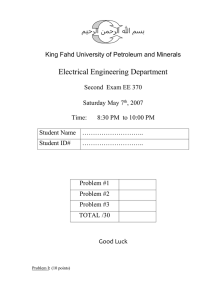
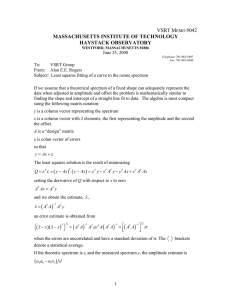
![ ]. ) /](http://s2.studylib.net/store/data/015834125_1-06c22f0bdc3e34adb72b4710444befe7-300x300.png)
